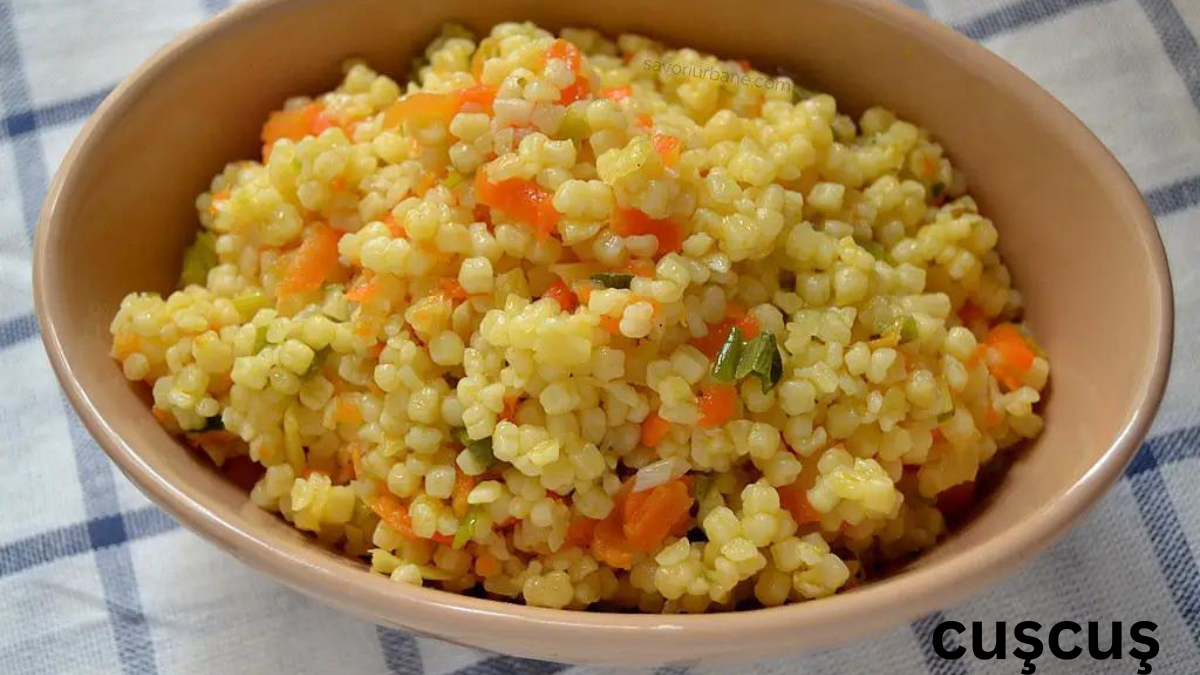
Introduction to Cuşcuş
What comes to mind when you think of a diverse, easy-to-make, and healthful dish? For many, it’s cuşcuş. But what precisely is cuşcuş? This small, granular pasta produced from semolina wheat has a long history and is a staple in many cultures. Let’s dig into the world of and examine its origins, kinds, nutritional advantages, and much more.
Origins and Cultural Significance
North African Roots
Cuşcuş has significant origins in North African cuisine, notably in nations like Morocco, Tunisia, and Algeria. It’s commonly regarded a sign of North African culinary identity and is vital to many traditional meals.
Mediterranean Influence
Beyond North Africa, cuşcuş has found its way into Mediterranean cuisine, influencing recipes in nations like Italy, France, and Spain. Its versatility and simplicity of preparation have made it a popular option across numerous culinary traditions.
Cultural Importance in Various Regions
Cuşcuş is more than simply food; it’s a cultural totem. In many locations, it’s offered during special events, religious festivities, and family gatherings, emphasizing its relevance in social and cultural settings.
Types of Cuşcuş
Traditional Cuşcuş
Traditional cuşcuş’s is tiny and fine, produced from durum wheat semolina. It’s often cooked and served with a hearty stew of meat and vegetables.
Israeli Cuşcuş (Pearl Cuşcuş)
Israeli also known as pearl is bigger and rounder than regular It has a chewy texture and is frequently roasted before cooking to improve its taste.
Lebanese Cuşcuş
Lebanese or moghrabieh, is significantly bigger and typically used in heavy stews. It has a distinctive texture and absorbs tastes nicely, making it a favorite in Middle Eastern cuisine.
Nutritional Benefits of Cuşcuş
Rich in Carbohydrates
Cuşcuş’s is a fantastic source of carbs, giving energy to keep you going throughout the day. It’s an excellent alternative for people desiring a fast and sustaining dinner.
Source of Protein
Though not abundant in protein, does contain some, which is important for muscle repair and development. Pairing it with beans or meat may improve its protein content.
Low in Fat
Cuşcuş’s is naturally low in fat, making it a healthy option for people managing their fat consumption. It’s also devoid of cholesterol, adding to its heart-healthy characteristics.
How to Cook Cuşcuş
Basic Cuşcuş’s Recipe
Cooking is easy and fast. Start by heating water or broth, then mix in the cover, and let it steam for approximately 5 minutes. Fluff with a fork before serving.
Cooking Variations
There are various methods to prepare Some like to simmer it over a stew, enabling the grains to absorb the rich flavors, while others would toast it beforehand for a nutty taste.
Tips for Perfect Cuşcuş
To create ideal, fluffy use a fork to fluff it up after cooking. Avoid overcooking, and always use a 1:1 ratio of liquid to for the best results.
Popular Cuşcuş Dishes
Cuşcuş with Vegetables
And vegetarian treat, cuşcuş with veggies is a colorful and healthful meal. It often comprises a combination of carrots, zucchini, bell peppers, and chickpeas, seasoned with a variety of spices.
Cuşcuş with Meat
Cuşcuş’s goes nicely with meats like lamb, chicken, or beef. The beef is generally prepared in a flavorful stew with vegetables and spices, served over a bed of fluffy
Sweet Cuşcuş Variations
For a fresh twist, try sweet This variation may contain dried fruits, nuts, and a dusting of cinnamon and sugar, making it a great dessert or breakfast choice.
Cuşcuş in Different Cuisines
Moroccan Cuşcuş’s
Moroccan cis noted for its fragrant spices and the use of a special steamer called a couscoussier. It frequently comprises lamb, root vegetables, and a blend of spices including cumin and coriander.
Tunisian Cuşcuş
Tunisian cuşcuş’s is recognized for its spicy and powerful tastes. Harissa, a hot chili paste, is typically added, giving the meal a searing kick.
Algerian Cuşcuş
In Algeria, is commonly served with a rich tomato-based sauce and a variety of vegetables and meats. It’s a cozy and hearty dish, excellent for family gatherings.
Serving Suggestions
Best Side Dishes
Cuşcuş is flexible and works well with a range of side dishes, such as roasted vegetables, salads, and flatbreads. It may also be eaten with grilled meats or seafood.
Ideal Beverages
When serving try complementing it with traditional drinks like mint tea or a mild white wine. These beverages match the tastes of the food well.
Presentation Tips
For an appealing presentation, serve in a big, shallow dish, topped with a colorful variety of vegetables and meats. Garnish with fresh herbs for a bit of sophistication.
Cuşcuş for Special Occasions
Festive Cuşcuş’s Dishes
During festive events, is typically raised with unique ingredients like saffron, dried fruits, and nuts. These seasonings make the meal rich and joyful.
Cuşcuş in Religious Celebrations
In many civilizations, plays a key part in religious ceremonies. It’s a symbol of plenty and is typically eaten during Ramadan, Easter, and other big occasions.
Cuşcuş at Family Gatherings
Cuşcuş’s is a popular option for family gatherings owing to its capacity to serve a crowd and its warm, homely tastes. It’s a meal that draws people together around the table.
Health Considerations
Gluten-Free Alternatives
For people with gluten intolerance, there are gluten-free alternatives to conventional cuşcuş’s, such as quinoa or rice-based These solutions deliver comparable textures and tastes without the gluten.
Dietary Restrictions and Cuşcuş
Cuşcuş’s may be customized to match different dietary requirements. It’s simple to make vegetarian or vegan by removing meat and substituting veggie broth.
Cuşcuş for Weight Loss
Due to its minimal fat content and adaptability, may be a fantastic addition to a weight reduction diet. Pair it with lots of veggies and lean meats for a balanced dinner.
Cuşcuş in Modern Cuisine
Fusion Recipes
Modern chefs are combining cuşcuş’s into fusion recipes, merging it with ingredients and methods from different cuisines to produce creative meals.
Cuşcuş in Restaurants
Many restaurants now include on their menus, providing everything from traditional preparations to innovative new interpretations on this classic cuisine.
Gourmet Cuşcuş Dishes
Gourmet cuşcuş’s recipes sometimes add high-end delicacies like truffles, shellfish, or exotic spices, raising the simple grain to a refined level.
Buying and Storing Cuşcuş
Where to Buy Cuşcuş’s
Cuşcuş’s may be found in most supermarket shops, frequently on the foreign foods aisle. Specialty shops and internet sellers also provide a range of kinds.
How to Store Cuşcuş’s
Store uncooked cuşcuş’s in an airtight container in a cold, dry location. Cooked should be refrigerated and eaten within a few days.
Shelf Life of Cuşcuş
Uncooked cuşcuş’s has a long shelf life, often up to a year if kept correctly. Cooked should be consumed within 3-5 days for the finest quality.
Making Cuşcuş at Home
Homemade Cuşcuş Recipe
Making cuşcuş’s at home is straightforward. Combine semolina flour with a touch of water, shape into tiny granules, and steam until frothy. It’s a pleasant and fulfilling process.
Tools and Equipment Needed
To create cuşcuş’s, you’ll need a couscoussier or a steamer, a mixing dish, and a fork for fluffing. A decent grade semolina flour is also needed.
Common Mistakes to Avoid
Avoiding overcooking cuşcuş, since it might turn mushy. Always measure your liquid carefully and fluff the after steaming to achieve light, distinct grains.
Environmental Impact of Cuşcuş’s Production
Sustainable Farming Practices
Choosing cuşcuş’s from suppliers that follow sustainable agricultural techniques helps lessen your environmental impact. Look for organic and fair-trade choices.
Impact on Local Economies
Buying from local farmers helps support local economies and guarantee that your food is produced under fair and ethical circumstances.
Organic Cuşcuş Options
Organic cuşcuş’s is produced without synthetic pesticides or fertilizers, making it a healthier and more ecologically responsible alternative.
Conclusion
Cuşcuş is more than simply a meal; it’s a cultural symbol with a deep history and unlimited adaptability. From its North African beginnings to its modern-day uses, continues to amuse and feed people throughout the globe. Whether you’re a seasoned chef or an inquisitive eater, there’s always something new to discover with
FAQs about Cuşcuş
What is the difference between Cuşcuş’s and Quinoa?
Cuşcuş is a sort of pasta produced from semolina wheat, whereas quinoa is a seed from the goosefoot plant. They have varied textures and nutritional profiles, with quinoa being richer in protein.
Can Cuşcuş be made gluten-free?
Yes, gluten-free alternatives to conventional cuşcuş’s include quinoa and rice-based cuşcuş. These solutions provide comparable sensations without the gluten.
What are the best spices to use with Cuşcuş’s?
Popular spices for Cuşcuş’s include cumin, coriander, paprika, and cinnamon. Fresh herbs like parsley and cilantro also compliment its taste beautifully.
How long does it take to cook Cuşcuş?
Cooking normally takes around 5 minutes. Simply add boiling water or broth, cover, and let it steam before fluffing with a fork.
Is Cuşcuş’s good for meal prepping?
Yes, cuşcuş’s is wonderful for meal preparing. It stays nicely in the refrigerator and can be coupled with different meats and veggies for fast, healthful dinners throughout the week.

